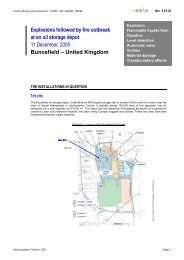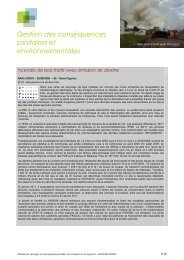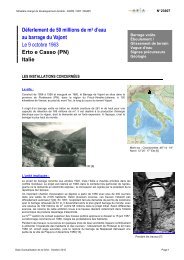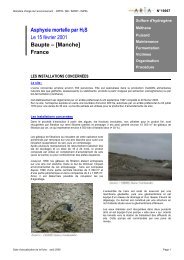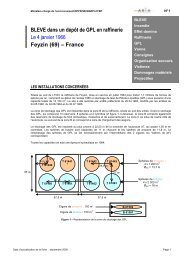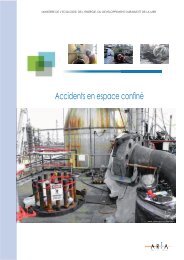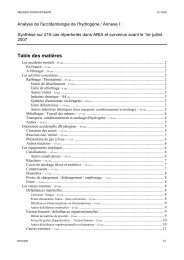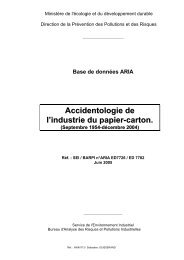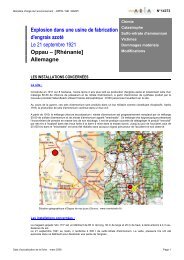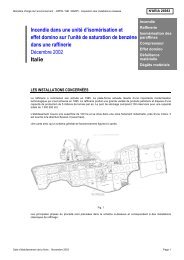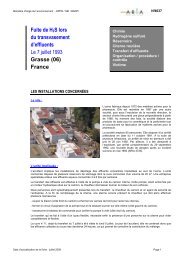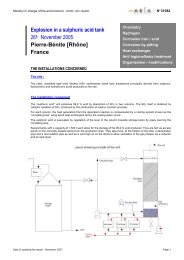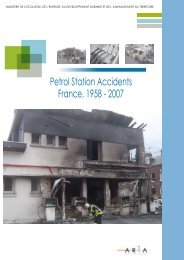VCM leak in a chemical plant 25th August 1999 Tavaux (Jura ... - Aria
VCM leak in a chemical plant 25th August 1999 Tavaux (Jura ... - Aria
VCM leak in a chemical plant 25th August 1999 Tavaux (Jura ... - Aria
Create successful ePaper yourself
Turn your PDF publications into a flip-book with our unique Google optimized e-Paper software.
French M<strong>in</strong>istry for Susta<strong>in</strong>able Development - DGPR / SRT / BARPI No. 16384<br />
<strong>VCM</strong> <strong>leak</strong> <strong>in</strong> a <strong>chemical</strong> <strong>plant</strong><br />
<strong>25th</strong> <strong>August</strong> <strong>1999</strong><br />
<strong>Tavaux</strong> (<strong>Jura</strong>)<br />
France<br />
THE FACILITIES INVOLVED<br />
The site:<br />
The Company, created <strong>in</strong> 1930, covers 100 ha and employs slightly less than 2,000 people on-site and groups together<br />
some 700 jobs <strong>in</strong> various service provid<strong>in</strong>g companies.<br />
All of the platform's manufactur<strong>in</strong>g operations are based on the transformation of salt <strong>in</strong>to chlor<strong>in</strong>e by electrolysis, which<br />
is used to make 3 plastic materials on site :<br />
√ polyv<strong>in</strong>yl chloride (PVC),<br />
√ polyv<strong>in</strong>ylidene chloride (PVDC),<br />
√ polyv<strong>in</strong>ylidene fluoride (PVDF).<br />
This establishment conta<strong>in</strong>s 8 <strong>in</strong>stallations which fall directly under the Sevesco directive. The establishment benefits<br />
from authorization orders which, on the one hand, set the general operat<strong>in</strong>g conditions for the entire operation and, on<br />
the other hand, regulate the fifteen or so <strong>in</strong>stallations which exist on the site. A POI ("Plan d'Organisation Interne",<br />
<strong>in</strong>ternal cont<strong>in</strong>gency plan) was drafted by the operator. An associated PPI ("Plan Particulier d'Intervention", emergency<br />
response plan) was established <strong>in</strong> 1992 and was revised follow<strong>in</strong>g an exercise conducted <strong>in</strong> 1995.<br />
The <strong>in</strong>volved unit:<br />
The <strong>in</strong>stallation concerned by the accident is the PVC manufactur<strong>in</strong>g facility, itself <strong>in</strong>clud<strong>in</strong>g 3 workshops. Workshop P69<br />
corresponds to the polymerisation of PVC by a "suspension" process. In order to better understand the progression of<br />
the accident, this process is detailed below.<br />
Production is carried out <strong>in</strong> a discont<strong>in</strong>uous manner, by "batch", with the reaction tak<strong>in</strong>g place <strong>in</strong> dual-cas<strong>in</strong>g autoclaves<br />
(a sta<strong>in</strong>less steel tank and steel cas<strong>in</strong>g) hav<strong>in</strong>g a volume of 27.5m³. The shop <strong>in</strong>cludes 13 autoclaves. The reaction<br />
takes place under a pressure of 6 to 9 bar and at a temperature from 40 to 70°C.<br />
The pr<strong>in</strong>ciple phases are as follows:<br />
√ dem<strong>in</strong>eralised water and dispers<strong>in</strong>g agents are loaded <strong>in</strong>to the autoclave,<br />
√ agitation,<br />
<strong>VCM</strong><br />
Organisation /<br />
Procedure<br />
Human / control flaw<br />
Autoclave<br />
File last updated: September2010 Page 1
French M<strong>in</strong>istry for Susta<strong>in</strong>able Development - DGPR / SRT / BARPI No. 16384<br />
√ the autoclave is closed and placed <strong>in</strong> a vacuum to remove the oxygen,<br />
√ 10 tons of v<strong>in</strong>yl chloride monomer (<strong>VCM</strong>) is loaded <strong>in</strong>to the autoclave,<br />
√ preheat<strong>in</strong>g to the polymerisation temperature by circulat<strong>in</strong>g hot water <strong>in</strong> the dual cas<strong>in</strong>g,<br />
√ polymerisation at constant temperature and the addition of reagents,<br />
√ depressurisation and transfer from the reaction environment to a different tank,<br />
√ the autoclave is placed under vacuum,<br />
√ degass<strong>in</strong>g of the residual <strong>VCM</strong>,<br />
√ prior to the launch of a new production cycle, the autoclave is<br />
opened by the manhole and cleaned us<strong>in</strong>g water at high<br />
pressure.<br />
Consider<strong>in</strong>g its importance <strong>in</strong> the tra<strong>in</strong> of events, further <strong>in</strong>formation is<br />
provided about the autoclave's closure mechanism (see photo opposite).<br />
It consists of a pivot<strong>in</strong>g system comprised of the manhole cover and an<br />
adjo<strong>in</strong><strong>in</strong>g elbow-shaped tube section enabl<strong>in</strong>g the autoclave to be<br />
connected to the overpressure protection system consist<strong>in</strong>g of a rupture<br />
disk and a valve mounted <strong>in</strong> series. A seal is required at 2 levels: one<br />
seal is located at the cover/manhole junction, and the other is located at<br />
the junction between the elbow tube and the stationary overpressure<br />
protection pipe. Two jaws, one at each level and actuated by a lever,<br />
ensure the overall tightness of the device.<br />
THE ACCIDENT, ITS CHRONOLOGY, EFFECTS AND CONSEQUENCES<br />
The accident:<br />
On <strong>August</strong> <strong>25th</strong>, the unit was operat<strong>in</strong>g normally. The cha<strong>in</strong> of events which characterizes the accident and how the<br />
accident was handled is presented below:<br />
Around 7:30 pm, a <strong>leak</strong> is detected on the autoclave at the start of the polymerisation phase. Poor visibility <strong>in</strong> the<br />
workshop does not allow the orig<strong>in</strong> of the <strong>leak</strong> to be determ<strong>in</strong>ed. Nitrogen is <strong>in</strong>jected to <strong>in</strong>hibit the reaction <strong>in</strong> the<br />
autoclave.<br />
Between 7h30 to 7h40 pm, the operator checks the concentration <strong>VCM</strong> <strong>in</strong> the atmosphere us<strong>in</strong>g portable devices <strong>in</strong> the<br />
immediate proximity of the build<strong>in</strong>g <strong>in</strong>volved <strong>in</strong> the accident.<br />
more than 1,000 ppm of <strong>VCM</strong> <strong>in</strong> the polymerisation hall are detected at 7:32 pm.<br />
The <strong>leak</strong> is located at 7:35 pm on the tube connection the roof of the autoclave to the rupture disk.<br />
At 8:02 pm, the operator prepares a foam <strong>in</strong>jection operation <strong>in</strong> order to reduce the risk of explosion <strong>in</strong>side the<br />
polymerisation hall. He activates the <strong>in</strong>ternal cont<strong>in</strong>gency plan due to the flammable characteristics of the gas emitted.<br />
Additional measurements of the concentration of <strong>VCM</strong> performed at various locations of the establishment, outside the<br />
polymerisation hall.<br />
At 8:55 pm the decision is made to transfer the contents of the <strong>leak</strong><strong>in</strong>g autoclave to the neighbour<strong>in</strong>g, empty autoclave.<br />
The transfer operation is started at 9:10 pm. The <strong>leak</strong><strong>in</strong>g autoclave is depressurised to atmospheric pressure at 9:40<br />
pm. The chromatographs record a rapid decrease <strong>in</strong> the <strong>VCM</strong> content <strong>in</strong> the polymerisation hall.<br />
The rapid improvement of visibility <strong>in</strong> the hall enables the <strong>in</strong>tervention by an operator and a fireman : they report that the<br />
jaws of the closure system on the autoclave/rupture disk junction are loose. The jaws were put back <strong>in</strong>to correct position<br />
after hav<strong>in</strong>g bent the safety rod (prevent<strong>in</strong>g the closure manoeuvre).<br />
The transfer is completed at 10 pm and the <strong>leak</strong> is under control.<br />
Consequences of the accident:<br />
The accident claimed no victims. Although <strong>VCM</strong> is a highly flammable and explosive substance, the <strong>leak</strong> did not result <strong>in</strong><br />
a fire or explosion.<br />
File last updated: September2010 Page 2
French M<strong>in</strong>istry for Susta<strong>in</strong>able Development - DGPR / SRT / BARPI No. 16384<br />
The European scale of <strong>in</strong>dustrial accidents<br />
By apply<strong>in</strong>g the rat<strong>in</strong>g rules applicable to the 18 parameters of the scale officially adopted <strong>in</strong> February 1994 by the<br />
Member States' Competent Authority Committee for implement<strong>in</strong>g the ‘SEVESO II’ directive on handl<strong>in</strong>g hazardous<br />
substances, and <strong>in</strong> light of the <strong>in</strong>formation available, this accident can be characterised by the four follow<strong>in</strong>g <strong>in</strong>dices:<br />
The parameters compos<strong>in</strong>g these <strong>in</strong>dices and their correspond<strong>in</strong>g rat<strong>in</strong>g protocol are available from the follow<strong>in</strong>g<br />
Website: http://www.aria.developpement-durable.gouv.fr<br />
The overall score of the "Hazardous materials released" <strong>in</strong>dex was assigned a "3", as the quantity of <strong>VCM</strong> released was<br />
evaluated at 6.1 tonnes (parameter Q1: quantity ly<strong>in</strong>g between 1% and 10% of the SEVESO threshold).<br />
S<strong>in</strong>ce no human, environmental or economic consequences were reported, the correspond<strong>in</strong>g <strong>in</strong>dices were all rated a<br />
"0".<br />
THE ORIGIN, CAUSES AND CIRCUMSTANCES SURROUNDING THE ACCIDENT<br />
The <strong>in</strong>quiry showed that the launch of the operation was prepared normally and the technician began the habitual<br />
procedures, particularly the closure of the autoclave. However, the technician forgot to tighten the jaws of the previously<br />
described mechanism.<br />
The polymerisation began after the vacuum operations and the load<strong>in</strong>g of the product were carried out.<br />
The <strong>leak</strong> did not occur immediately: only when the pressure was sufficiently high, that is to say at the end of the heat<strong>in</strong>g<br />
phase, the <strong>leak</strong> occurred suddenly at the "quick" junction. The mechanism rema<strong>in</strong>ed <strong>in</strong> place although the seal slipped<br />
out of its hous<strong>in</strong>g caus<strong>in</strong>g the <strong>leak</strong>.<br />
The <strong>VCM</strong> spread through the workshop than to the exterior via the facility's mechanical ventilation system.<br />
ACTIONS TAKEN<br />
The regulated facility <strong>in</strong>spectorate carried out their <strong>in</strong>spection the next day. The operator was questioned about various<br />
subjects, <strong>in</strong>clud<strong>in</strong>g the exposure of the surround<strong>in</strong>g population to <strong>VCM</strong>. Beyond its flammable characteristics, <strong>VCM</strong> is<br />
also classified as carc<strong>in</strong>ogenic (category 1 <strong>in</strong> the European classification, group 1 as per the CIRC - category F+; risk<br />
phrase R12-45. It is thus important to have a study relative to the consequences on the surround<strong>in</strong>g population.<br />
The same day, the <strong>in</strong>spectorate proposed a draft order <strong>in</strong> accordance with the emergency procedure, request<strong>in</strong>g:<br />
√ that a study be conducted on the consequences of the emissions generated <strong>in</strong> the environment,<br />
√ that a study be conducted on the precise circumstances of the accident <strong>in</strong> order to determ<strong>in</strong>e the causes as<br />
well as the means to be implemented to prevent such situations from happen<strong>in</strong>g aga<strong>in</strong>.<br />
Accord<strong>in</strong>g to conclusions drawn from a third-party expert's report, the average concentration of <strong>VCM</strong> would have<br />
rema<strong>in</strong>ed considerably below the lower explosive limit (roughly 10 times less) over the entire polymerisation facility. On<br />
the other hand, the critical concentration range (i.e. between the lower and upper explosive limits) must at times have<br />
been reached, yet without trigger<strong>in</strong>g ignition.<br />
As for the toxic risk, the most credible estimation of the <strong>leak</strong> <strong>in</strong>dicates a <strong>VCM</strong> discharge quantity of 6,100 kg. This<br />
calculation furthermore demonstrates that the population liv<strong>in</strong>g <strong>in</strong> the closest dwell<strong>in</strong>gs along the direction of the w<strong>in</strong>d,<br />
i.e. at 1,350 m, was exposed to concentrations on the order of 3 to 5 ppm for a 2-hour duration. By adopt<strong>in</strong>g worst-case<br />
hypotheses, the concentrations derived yield maximum values <strong>in</strong> the range of 50 to 80 ppm. In the words of the expert:<br />
"The health risk for those exposed rema<strong>in</strong>s negligible."<br />
File last updated: September2010 Page 3
French M<strong>in</strong>istry for Susta<strong>in</strong>able Development - DGPR / SRT / BARPI No. 16384<br />
LESSONS LEARNT<br />
In response to the reported human failure, a mechanical device was <strong>in</strong>stalled by the operator. It now detects where the<br />
not the jaws are actually tightened dur<strong>in</strong>g the autoclave vacuum operation.<br />
The device and the correspond<strong>in</strong>g procedures were <strong>in</strong> place as of late <strong>1999</strong> on all of the autoclaves of the same type<br />
and operat<strong>in</strong>g discont<strong>in</strong>uously.<br />
Thought was given to the autoclaves of the other "close process" manufactur<strong>in</strong>g units and which are opened less often.<br />
The operat<strong>in</strong>g procedures have been completed and now <strong>in</strong>clude tests prior to pressurization and depressurisation<br />
before the <strong>in</strong>troduction of products <strong>in</strong> to the reactors. The deadl<strong>in</strong>e objective was set for May 2000.<br />
Thought was also given concern<strong>in</strong>g the modification of <strong>in</strong>tervention plans <strong>in</strong> order to <strong>in</strong>tegrate the feedback elements<br />
collected after the <strong>in</strong>cident.<br />
File last updated: September2010 Page 4



